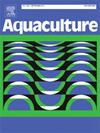MLKL promotes extracellular trap releasing in Vibrio splendidus AJ01-challenged coelomocytes of sea cucumber Apostichopus japonicus
IF 3.9
1区 农林科学
Q1 FISHERIES
引用次数: 0
Abstract
Extracellular traps (ETs) is a novel host-defense mechanism for the immobilization and killing of invading microorganisms, of which pseudokinase mixed lineage kinase-like protein (MLKL) is necessary for ET formation. Here, we aimed to investigate the effects of various stimulations (including classic ET inducers and pathogen) on ET formation in the coelomocytes of invertebrate sea cucumber Apostichopus japonicus. Our results show that stimulation of sea cucumber coelomocytes with phorbol 12-myristate 13-acetate (PMA), zymosan, Vibrio splendidus AJ01, and AJ01 flagella all led to the formation of typical ET fibers, which can be further digested by DNase I. This finding suggests that DNA is an essential component of coelomocyte ETs. Meanwhile, the signals of histones H2A and H2B transferred to extracellular spaces and colocalized with AJ01, which indicates that histones are also crucial components of coelomocyte ETs. Scanning electron microscopy observation and antimicrobial activity analysis successfully revealed that AJ01 was trapped and killed by ET fibers, and this finding implies the antimicrobial role of sea cucumber coelomocyte ETs. More importantly, silencing and inhibition of AjMLKL after AJ01 infection not only considerably depressed ET generation but also increased the survival rate of AJ01. All our results indicate that AjMLKL mediates sea cucumber ET formation and plays critical roles during pathogen infection.
MLKL 促进绚丽弧菌 AJ01 挑战的海参 Apostichopus japonicus 腹腔细胞释放胞外捕获器
细胞外陷阱(ETs)是一种新型的宿主防御机制,用于固定和杀死入侵的微生物,其中伪激酶混合系激酶样蛋白(MLKL)是ET形成的必要条件。在此,我们旨在研究各种刺激(包括经典的ET诱导剂和病原体)对无脊椎动物海参(Apostichopus japonicus)腹腔细胞ET形成的影响。我们的研究结果表明,用光滑醇-12-肉豆蔻酸 13-乙酸酯(PMA)、玉米素、灿烂弧菌 AJ01 和 AJ01 鞭毛刺激海参腹腔细胞都会导致典型 ET 纤维的形成,这些纤维可被 DNase I 进一步消化。同时,组蛋白H2A和H2B的信号转移到细胞外空间并与AJ01共定位,这表明组蛋白也是螺旋体ET的重要组成部分。扫描电镜观察和抗菌活性分析成功揭示了AJ01被ET纤维捕获并杀死,这一发现暗示了海参腹腔细胞ETs的抗菌作用。更重要的是,在AJ01感染后沉默和抑制AjMLKL,不仅大大抑制了ET的生成,而且提高了AJ01的存活率。所有这些结果表明,AjMLKL介导海参ET的形成,并在病原体感染过程中发挥关键作用。
本文章由计算机程序翻译,如有差异,请以英文原文为准。
求助全文
约1分钟内获得全文
求助全文
来源期刊

Aquaculture
农林科学-海洋与淡水生物学
CiteScore
8.60
自引率
17.80%
发文量
1246
审稿时长
56 days
期刊介绍:
Aquaculture is an international journal for the exploration, improvement and management of all freshwater and marine food resources. It publishes novel and innovative research of world-wide interest on farming of aquatic organisms, which includes finfish, mollusks, crustaceans and aquatic plants for human consumption. Research on ornamentals is not a focus of the Journal. Aquaculture only publishes papers with a clear relevance to improving aquaculture practices or a potential application.
 求助内容:
求助内容: 应助结果提醒方式:
应助结果提醒方式:


